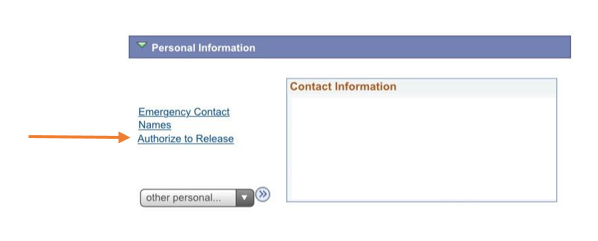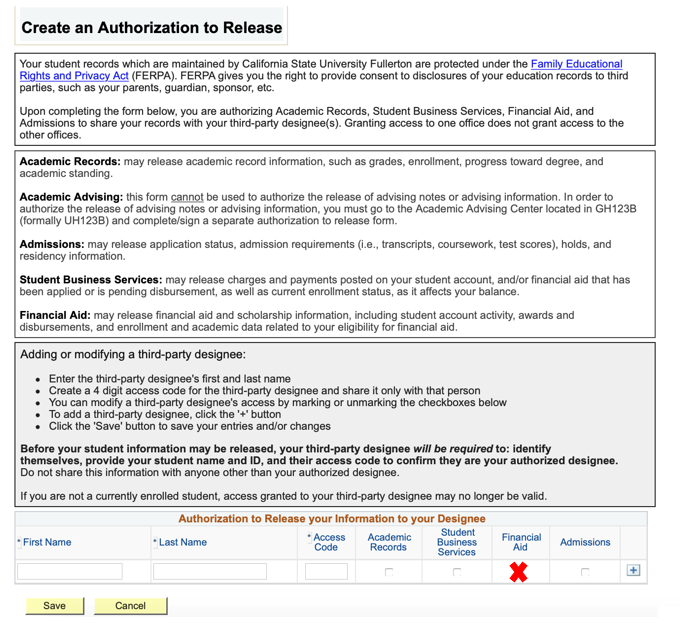FERPA
What is FERPA?
FERPA is the Family Educational Rights and Privacy Act (FERPA) and it is a Federal law that protects the privacy of student education records. The law applies to all schools that receive funds under an applicable program of the U.S. Department of Education. One purpose of FERPA is to protect the privacy of information concerning individual students by placing restrictions on the disclosure of information contained in an individual student's educational record. FERPA provides students certain rights with respect to their educational records. This means that access to your information is limited to yourself and authorized individuals.
What Does FERPA Gives Students Rights To?
- The right to inspect and review their educational records.
- The right to request the amendment of their education records to ensure that they are not inaccurate misleading or otherwise in violation of their privacy or other rights.
- The right to consent to disclosures of personally identifiable information contained in their education records, except to the extent that FERPA authorizes disclosure without consent. FERPA permits disclosures without consent to “school officials” with “legitimate educational interests.” “School officials” include university employees (including law enforcement unit and health personnel); agents of the University (such as an attorney or collection agent); or individuals, including students, serving on official committees or assisting a school official perform his/her tasks. A school official has a “legitimate educational interest” if the official needs to review an education record to fulfill his/her professional responsibility. Upon request, the University discloses education records without consent to officials of another school in which a student seeks to enroll. California State University, Fullerton has designated as “Directory” information a student’s name, date and place of birth, permanent and local address, university-recognized e-mail address(es), photograph, telephone number, class level, enrollment status, major, minor, dates of attendance, degrees and awards received, previous educational institutions attended, past and present participation in recognized activities, and weight and height if an athletic team member. Unless restricted by the student, the campus may release Directory information at any time to any requesting party, including the military and for the development of university-affiliated marketing programs. Students may choose to limit the release of their Directory information in one of four ways:
- Permit release of all Directory information for any purpose. No further action by the student is required.
- Permit release of only “Verification” information. This sub-category of Directory information consists of a student’s name, class level, enrollment status, major, minor, degrees and awards received, dates of attendance, and university-recognized e-mail address(es). The University will release this information for classroom use; in response to requests, including those from financial lenders, employers or insurance companies for verification of degree and enrollment information; and for inclusion in Commencement and honors materials. Students who release only “Verification” information will be excluded from all university directories.
- Permit release of only “Class” information. This sub-category of Directory information consists of a student’s name, major, minor, degree and awards received, and university-recognized e-mail address(es). The University will release this information for classroom use and for inclusion in Commencement and honors materials. Students who release only “Class” information will be excluded from all university directories, and the University will not respond to requests, including those from financial lenders, employers or insurance companies, for verification of degree, dates of attendance or enrollment status.
- Withhold the release of all Directory information. Withholding the release of all Directory information means that the student will be excluded from all university directories and publications, including Commencement and honors materials, and the University will not verify degree, dates of attendance or enrollment status without the prior written consent of the student.
- Students may select at any time, the level of release by logging on to the Student Portal or visiting the Admissions and Records Service Center located in room 114 on the first floor of Langsdorf Hall. Unless a student designates otherwise, the university will assume that a student has chosen to permit access to their Directory Information for any purpose.
- The right to file with the U.S. Department of Education a complaint concerning alleged failures by California State University, Fullerton to comply with the requirements of FERPA. The Office that administers FERPA is: Family Policy Compliance Office, U.S. Department of Education, 400 Maryland Avenue, SW, Washington, DC 20202-4605.
- The right to obtain a copy of California State University, Fullerton’s student records policy. A copy of this policy may be obtained from the Office of the Vice President for Student Affairs, Langsdorf Hall 805.
How Does FERPA Impact Financial Aid?
FERPA prohibits the Office of Financial Aid from sharing information about your application to anyone other than you. Even if you are considered independent and provided information from your parents, we can not share this with them without prior consent from you.
Instructions to provide authorization to the Office of Financial Aid to release your student financial aid information:
- To provide authorization to another person on your behalf, please visit your Student Center.
- On the bottom left hand side of the screen, you will see a "Personal Information" area. Select "Authorize to Release".
- Once you have selected "Authorize to Release", you will be directed to the electronic form. Please be sure to read the instructions. At the bottom, you will be able to add the information of the person you are authorizing to access your information.
- Be sure to share the authorization code with the individual to whom you are granting access.
- Lastly, please ensure that you check "Financial Aid" in order to authorize another person to speak to Financial Aid on your behalf. Below are examples of the location of "Authorize to Release" link and the Authorization to Release electronic form.


CSUF departments have their own FERPA authorization forms and this includes SBS and Financial Aid. Students must sign separate FERPA authorization forms with SBS and Financial Aid, and other departments on campus that they want to give others authorization.
